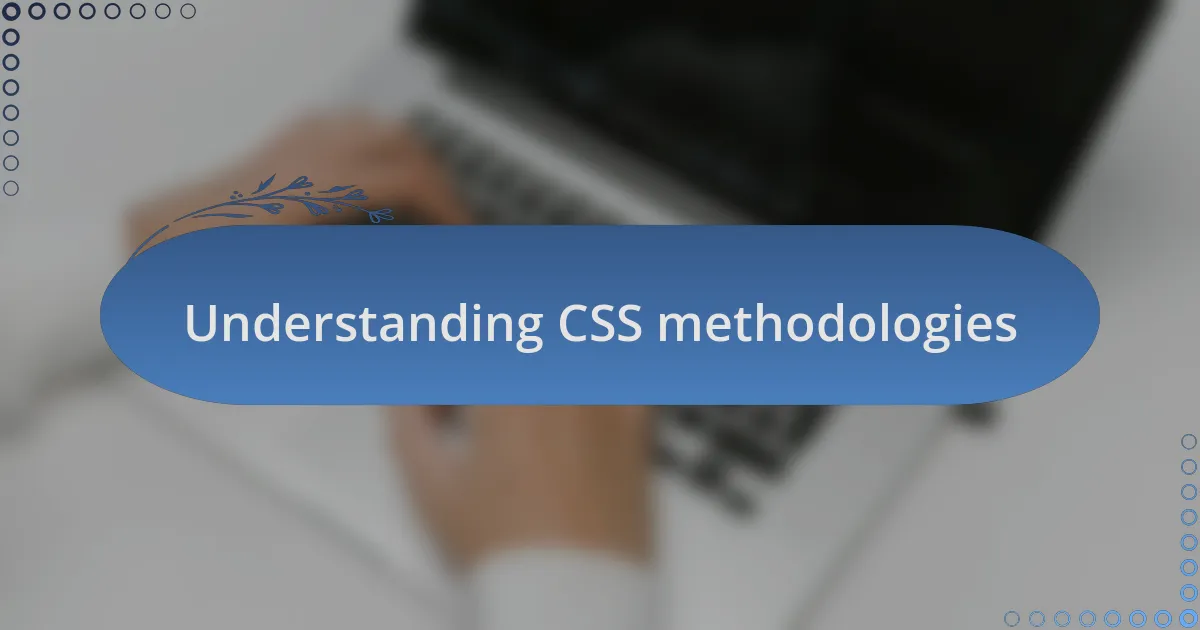Key takeaways:
- Understanding CSS methodologies like BEM, OOCSS, and SMACSS can enhance development processes and improve collaboration.
- BEM’s structured approach simplifies component creation, while SMACSS categorizes styles, making navigation easier.
- Utility-first methodologies, such as Tailwind CSS, shift how styles are applied, facilitating a more efficient workflow.
- Future trends include utility-first frameworks, CSS-in-JS libraries, and modular CSS with tools like PostCSS for enhanced customization.

Understanding CSS methodologies
When I first dove into CSS methodologies, I felt a mix of excitement and overwhelm. The vast array of methodologies—like BEM, OOCSS, and SMACSS—can make one wonder where to begin. Each method has its own philosophy and structure, and understanding these can significantly streamline your development process.
BEM (Block Element Modifier) struck me as particularly empowering. Its clear structure makes it easier to create reusable components, which is something I struggled with in my early projects. By dividing styles into blocks, elements, and modifiers, I discovered a new way to think about components that not only improved my workflow but also made collaboration with other developers more coherent.
I often reflect on the moment I realized the importance of choosing a CSS methodology. After working on a team project where inconsistent styles caused chaos, I appreciated how a solid methodology could bring order to the madness. Have you ever found yourself tangled in a web of mismatched styles? I assure you, adopting a clear methodology can save you from the frustration I faced and lead to a more harmonious coding experience.

Overview of common CSS methodologies
One of the most common CSS methodologies is OOCSS (Object-Oriented CSS). This approach emphasizes the separation of structure and skin, which resonated with my desire for clean and logical code. I remember my earlier projects, where style definitions were often intermingled with HTML, leading to messy results. OOCSS taught me the value of thinking of components as reusable objects, enhancing not just my code’s clarity, but also its maintainability.
Another popular methodology is SMACSS (Scalable and Modular Architecture for CSS). It really opened my eyes to the idea of categorizing styles based on their function, which felt liberating. I distinctly remember restructuring my CSS files for a large application, and how categorizing rules into “Base,” “Layout,” and “State” made navigation effortless. Have you ever stared at a style sheet and felt lost? With SMACSS, I found that organizing my approach around these categories provided a practical roadmap for my development process.
Lastly, I can’t overlook utility-first CSS methodologies like Tailwind CSS. While initially daunting, I soon discovered that this method promotes a unique way of applying styles directly in HTML without the overhead of managing a separate CSS file. This shift forced me to rethink my previous reliance on classes, pushing me toward a more efficient workflow. Have you ever wished you could code without constantly checking back and forth between files? Embracing utility-first principles made that dream a reality for me, turning code into a fluid experience.

My experiences with CSS methodologies
I’ve dabbled with BEM (Block Element Modifier) methodology, and it truly transformed the way I approach styling. I recall a project where my team struggled with class naming conventions; the chaos often led to clashes and overrides. Once I embraced BEM, everything shifted. The clarity of defining blocks, elements, and their modifiers made my code not just easier to read but significantly more intuitive. Have you ever felt overwhelmed by CSS specificity issues? BEM helped me avoid that frustration by providing a structured system that kept my styles organized.
Another methodology that stands out for me is ITCSS (Inverted Triangle CSS). Initially, the hierarchy felt strange, prioritizing the base styles first before moving to components and utilities. However, I remember implementing it in a sizeable e-commerce site where the shift in mindset made perfect sense. The pyramid structure allowed me to manage global styles and specifics with ease, reducing redundant code significantly. It’s incredible how a change in perspective can lead to such a powerful simplification. Do you find yourself struggling with CSS specificity wars? ITCSS might just be the solution you’ve been searching for.
Reflecting on my journey with CSS methodologies, I think about how each approach has equipped me with tools for better coding practices. When I started, I often felt like I was on an eternal learning curve, trying to grasp what worked best for my projects. The real epiphany came when I realized that, just like any skill, finding the right methodology is deeply personal. What resonates with one developer may not strike a chord with another. Have you found your CSS methodology match yet? It took time, but the journey has been worth every line of code.

Future trends in CSS methodologies
As I look to the future of CSS methodologies, I can’t help but feel a sense of excitement about the rise of utility-first frameworks like Tailwind CSS. During my recent projects, I found that utility classes simplified my workflow significantly. But have you ever experienced that moment of realization when minimalism meets creativity? It’s thrilling to compose styles using predefined classes, allowing for rapid prototyping without compromising on design.
Another trend I’ve noticed is the embracing of CSS-in-JS approaches. I’ve experimented with libraries like styled-components, and the integration of styles within JavaScript is liberating. Doesn’t it feel like we’re redefining the boundaries of separation between style and function? This confluence allows for dynamic styling based on component state, and I find that level of interactivity invigorating.
Looking ahead, I anticipate a stronger focus on modular CSS with frameworks such as PostCSS gaining traction. My last project utilized PostCSS, and it was fascinating to see how plugins enabled me to adopt modern CSS features seamlessly. I wonder if we’ll eventually move to a place where every developer feels empowered to customize their workflows using such configurable tools. The future of CSS methodologies certainly feels innovative, doesn’t it?